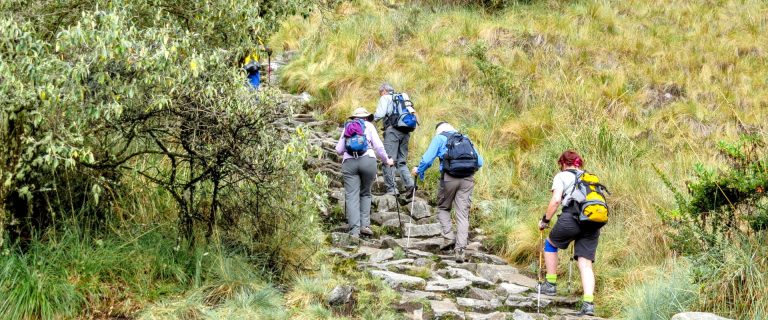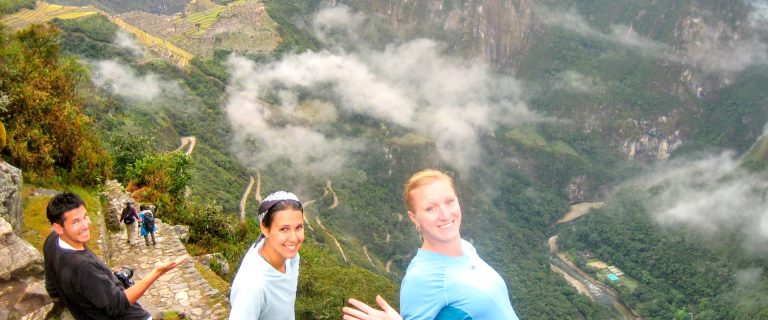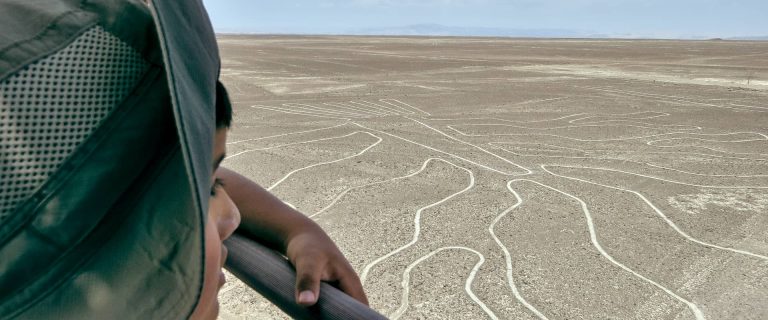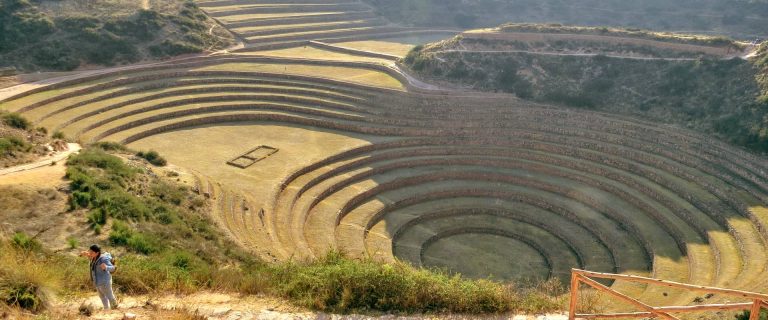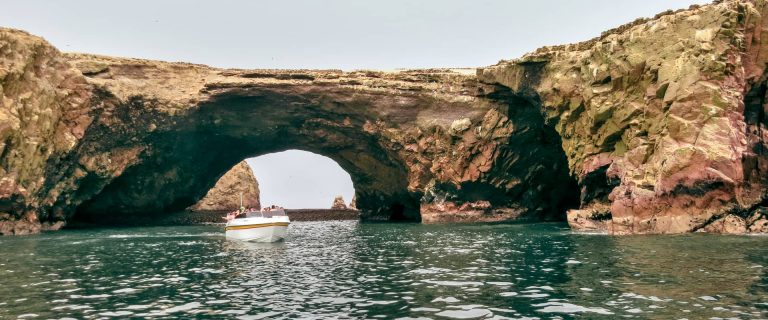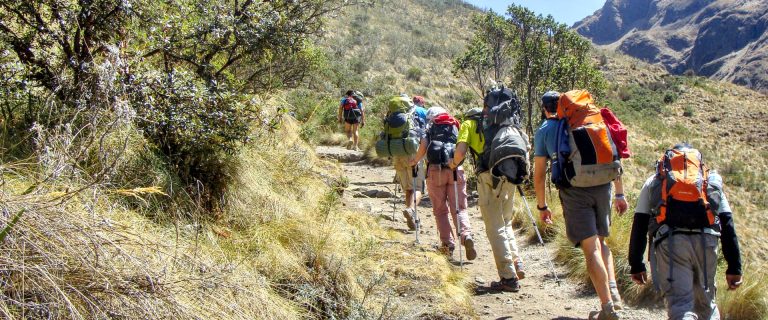This is a wonderful itinerary that incorporates a wide range of cultures, landscapes, Inca Ruins, and hiking the Inca Trail to Machu Picchu! We book this program for you on a custom/private basis. This way we can tailor it to your preferences. For instance, you can add an Amazon lodge stay and/or the Colca Canyon, and choose the types of hotels you prefer.
Discover splendid mountain panoramas in the Andes, enjoy a cultural immersion on Taquile Island, visit the vast Inca Trail sites and ruins–all a rich human canvas spanning thousands of years. Cruise to Lake Titicaca, the highest navigable lake in the world, with an overnight at the timeless Taquile Island. Stop at the unique floating reed islands of the Uros people. Explore Cuzco’s wondrous palaces, streets and plazas. Hike the famous Inca Trail to Machu Picchu, with a full day to explore the legendary Lost City of the Incas. Each day you enjoy unforgettable wonders.
At night in cities and towns you stay in small, delightful hotels, and enjoy an unforgettable night in a native home on the Quechuan Taquile Island on 12,500-foot Lake Titicaca. During the 4-day Inca Trail tour to Machu Picchu, you enjoy our top-quality trail service with porters, cooks and full camp service. Our guides are talented English-speaking Peruvians who contribute enthusiasm and valuable personal insights into the past and present of this astonishing Andean region.
2024, Custom Program
Departures: Any day, March – December
Trip Cost from Lima: Customized program cost to be determined based on the final itinerary. Please contact Best Andes Travel to work up a customized program to your liking.
Internal air: $373 (Air rate is subject to change)
Itinerary
Included in Land Cost:
All land transportation, in private bus or common carrier where trains are used; the Machu Picchu National Sanctuary trail fee $110 (subject to change.) Airport transfers on scheduled arrival and departure days; entrance fees to museums and sites mentioned in itinerary: Santa Catalina Convent, Museo de Santuarios Andinos, Uros Islands, Taquile island, Raqchi, Cuzco cathedral, Santo Domingo/Koricancha; shared twin accommodation in comfortable hotels, one night in homes of islanders on Taquile (single hotel accommodation available at extra cost); meals as indicated; tips for group baggage handling.
Not included in Land Cost:
International and internal airfare; airport fees and border taxes; beverages with included meals; meals not specified as included in the itinerary; insurance, laundry, and other items of a personal nature; your guide’s tip.
Weight Restriction: We include porterage for up to 10 kg (22 lb.) of personal gear. If your packed duffel exceeds 10 kg. In weight (including sleeping bag and pad) at the trailhead, you will have to transfer excess items from your duffel to your daypack.
FAQ: Trail Permits in Machu Picchu Sanctuary
Q: Do I need to buy a trail permit to hike on the Inca Trail to Machu Picchu?
A: Yes. All who use the hiking trails in the Machu Picchu Historic Sanctuary are required to purchase a trail permit. Companies which claim to offer you a trek that does not require a permit are offering a trek which does not enter the Machu Picchu Sanctuary. Permits sell out 6 months prior to departure, so please book far in advance in insure a permit!!!
But on our custom program, you can choose any other trek we offer, and those that do not go on the Inca Trail will not require permits.
Q: How do I buy the permit?
A: As part of confirming you on one of our treks, we purchase permits not only for you but for the porters and other trek crew who haul your gear and look after trek operations. In the following discussion, we use “permit” in both the singular sense (“you need a permit to trek in the park”) and in the collective sense (“we purchase a permit for 8 passengers plus trek crew”). Before we can purchase your permit, we need: your full name as it appears on your valid passport (IMPORTANT: check the passport expiry date!), your passport number, your date of birth, and gender. This information appears in the official trail documents and is checked carefully against your passport at control gates on the trail. If the information does not match, you may be refused access to the park and lose your trek.
Q: I need to renew my passport. How can I get a permit without a valid passport?
A: We can purchase the permit using your expired passport number. You then must bring both the expired passport and your new passport with you on the trail, and present both documents at the checkpoints. If your passport agency does not return your original passport, then it is essential that you keep a photocopy of the ID page of the original passport, and bring that with you to Peru. If you have no passport at all, then you cannot join a trek until you obtain a passport. If your name or passport number varies from what you supplied to us for the permit application, then the park authority may deny you access to the trail. Therefore, it is essential that you supply accurate passport data, and bring this passport with you to the trek.
Q: I noticed that I gave you an incorrect passport number when I applied to join the trek. Can you fix that?
A: So long as permits are available for your trek date, we can purchase a new permit with the new passport number to allow you to participate in the trek. The cost of the original permit is non-refundable. At the trek orientation you will have to pay for both the old permit and the new permit. If no more permits are available, then park authorities may refuse to grant you access to the Inca Trail if your passport number does not match that listed on the permit.
Q: I lost my passport which I gave you to purchase the permit. I’m applying for a new one. What happens now?
A: So long as permits are available for your trek date, we can purchase a new permit with the new passport number to allow you to participate in the trek. The cost of the original permit is non-refundable. At the trek orientation you will have to pay for both the old permit and the new permit. If no more permits are available, then park authorities may refuse to grant you access to the Inca Trail if your passport number does not match that listed on the permit.
Q: Is it possible to join a trekking group close to the trek departure date?
A: For all dates but those very early and very late in the trekking season, the answer is a resounding NO. Trekking permits sell out typically three months ahead of the trek date. The park authorities allow only 500 people to enter the park for any given day. Each person who enters that day needs to be listed on a permit, including guides, cooks, porters, and trekkers. From the end of March through the end of October, if you’re not on a roster three months prior to your trek, you’ll likely find that no permits are left. When that happens, you have two options – change your holiday dates, or trek outside the Machu Picchu Historic Sanctuary. For an excellent alternate route, we suggest our Moonstone to Sun Temple Trek.
Q: Do other companies have allocations of permits that I can purchase after your supply is sold out?
A: No. The park authority sells the permits on a first-come, first-served basis. The permit must specify for each trekker the full name, nationality, passport number, date of birth, and gender. Permits are not transferable, and the only change allowed on the permit is a full cancellation of one or more passengers. The result is that outfitters can buy permits only for passengers actually on their rosters. Once the 500 permits are issued, no more are available from any source.
Q: What about late cancellations?
A: Current regulations do not allow us to replace cancelled passengers with new passengers. Trek permits are non-refundable and non-transferable.
Q: If I give you my deposit now, do you buy my permit immediately?
A: Not unless permits are very low. We customarily purchase the permits within a few days of receiving your deposit.
Q: Can I enter Machu Picchu ruins at night on my trek permit?
A: No. Night-time entry to the Machu Picchu ruins is currently prohibited by the INC. Q: Are there student discounts for the trail permit?
A: For students 16 years and older, we must receive a digital version of your International Student Card (ISIC), showing the institution, student status, and date of validity. A .JPG file sent to us as an email attachment is the best format to achieve this. For those who will be younger than 16 years at the time of trekking, send a .JPG of the passport ID page. We submit the documentation when we purchase the permit. If the park authority accepts the documentation, then they will issue the permit at the student rate of 50% of the adult rate. If the park authority rejects the documentation, their decision stands and we purchase the adult-rate ticket. Either way, we charge you the actual amount we pay for the permit. The June 18, 2005 regulation specifies that ONLY an ISIC will be accepted; and that the original ISIC must be brought on the trek. Trekkers on student rate tickets who cannot produce ISIC at the trailhead will be charged the difference between student rate and adult rate tickets.
Q: If I change trek dates can I transfer my permit?
A: Both your trail permit and your trek deposit are non-refundable and non-transferable. To join a new trek date, we have to start the permit process all over again.
Quick Facts
- Custom Program
- Sample itinerary 15 days: 4 nights camping, 9 nights hotel, 1 night native homestay
- Tailor the itinerary to your preferences
- Cruise Lake Titicaca and enjoy native homestay on Taquile Island
- Explore magnificent Inca and colonial remains in Cuzco
- Trek the famous Inca Trail to Machu Picchu
- 4-day optional Amazon Lodge Extension
- Other add-ons available

